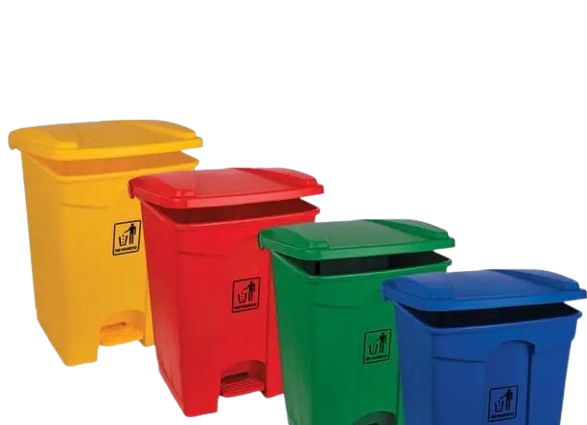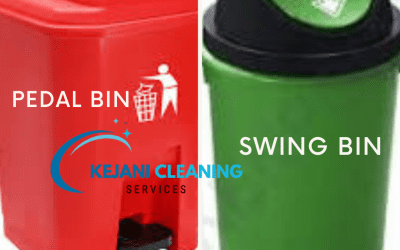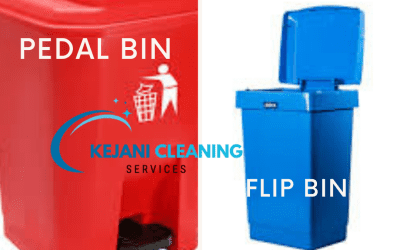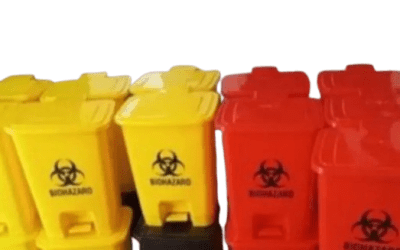Managing waste effectively is more than just having a dustbin — it’s about sorting waste to minimize environmental impact, improve hygiene, and comply with regulations. One of the most effective tools in this system is the color-coded pedal bin. Whether in hospitals, schools, offices, or homes, color-coded bins help identify and separate different types of waste, reducing contamination and promoting recycling.
In this guide, Kejani Cleaning Services Limited walks you through the types, uses, and benefits of color-coded pedal bins, tailored specifically for the Kenyan market.
What Are Color-Coded Pedal Bins?
Color-coded pedal bins are waste containers fitted with a foot-operated lid and painted in specific colors to indicate the type of waste they should hold. They are ideal for hands-free operation, especially in hygiene-sensitive environments such as hospitals, kitchens, and schools.
Why Use Pedal Bins?
-
✅ Hands-Free Operation: Reduces contact with waste and germs
-
✅ Improves Hygiene: Especially in food, healthcare, and public spaces
-
✅ Easy Waste Segregation: Clear identification using color coding
-
✅ Supports Recycling & Compliance: Encourages responsible disposal
Common Color Codes and Their Meanings in Kenya
The following color codes align with healthcare waste management guidelines, environmental best practices, and are used in institutional and industrial setups across Kenya.
🟥 Red Pedal Bins – Biohazard Waste
Use for:
-
Human anatomical waste
-
Blood-soaked materials
-
Contaminated dressings
-
Gloves, PPEs from infectious zones
Ideal Locations:
-
Hospitals, dental clinics, isolation wards, and laboratories
Why It Matters:
Red bins help contain infectious waste, preventing the spread of disease and complying with OSHA and NEMA regulations.
🟨 Yellow Pedal Bins – Infectious & Pathological Waste
Use for:
-
Human tissues
-
Sharps containers
-
Microbiological cultures
-
Body fluids
Ideal Locations:
-
Operating theatres, pathology labs, and mortuaries
Why It Matters:
Yellow bins are essential in handling high-risk waste safely. The pedal design ensures there’s no need to touch the lid, maintaining hygiene.
⬛ Black Pedal Bins – General Waste (Non-Hazardous)
Use for:
-
Food wrappers
-
Office waste
-
Used tissues
-
Packaging materials
Ideal Locations:
-
Offices, homes, classrooms, malls, and restaurants
Why It Matters:
Black waste pedal bins help separate non-recyclable or general waste from hazardous materials. They are common in everyday use where contamination risk is low.
🟩 Green Pedal Bins – Biodegradable or Organic Waste
Use for:
-
Food scraps
-
Garden waste
-
Fruit peels
-
Tea bags, biodegradable items
Ideal Locations:
-
Kitchens, cafeterias, restaurants, gardens
Why It Matters:
Green pedal waste bins are perfect for compostable waste, helping in environmental conservation and waste-to-fertilizer efforts.
🟦 Blue Pedal Bins – Recyclables (Non-Infectious)
Use for:
-
Paper
-
Plastic bottles
-
Clean containers
-
Cardboard
Ideal Locations:
-
Offices, homes, schools, public recycling points
Why It Matters:
Blue pedal bins support Kenya’s recycling ecosystem by separating clean recyclables from other waste streams.
🟪 Purple Pedal Bins – Cytotoxic and Pharmaceutical Waste
(Less common, but relevant in specialized facilities)
Use for:
-
Expired medicines
-
Chemotherapy drugs
-
Cytotoxic items
Ideal Locations:
-
Pharmacies, oncology departments, research centers
Why It Matters:
Improper disposal of pharmaceutical waste is dangerous. Purple bins ensure safe and compliant disposal.
⚪ Clear Pedal Bins – Transparent Monitoring
Use for:
-
Sharps containers
-
Airport/Prison waste checks
-
Visible inspections
Ideal Locations:
-
Secure environments requiring waste visibility
Why It Matters:
Used where contents must be visible for safety reasons, especially in high-security or regulated environments.
Benefits of Using Color-Coded Pedal Bins
✅ Hygiene Control
Pedal operation prevents direct hand contact with the lid, reducing cross-contamination — essential in healthcare and food service.
✅ Streamlined Waste Disposal
Clear visual cues help users dispose of waste correctly, reducing confusion and contamination.
✅ Regulatory Compliance
Meets waste management standards recommended by KEBS, OSHA, and NEMA.
✅ Enhances Recycling Programs
When waste is sorted at the source, recycling becomes easier, cleaner, and more cost-effective.
✅ Versatile for All Environments
Color-coded pedal bins are useful in homes, offices, hospitals, schools, hotels, and factories.
Ideal Sizes and Materials
At Kejani Cleaning Services Limited, we offer color-coded pedal bins in various sizes:
| Size (Litres) | Recommended Use |
|---|---|
| 20 – 30L | Homes, small offices, toilets |
| 50 – 60L | Clinics, classrooms, restaurants |
| 120L – 240L | Hospitals, outdoor bins, malls |
Materials Available:
-
Durable plastic (lightweight & rust-proof)
-
Stainless steel (premium aesthetic, durable)
Where to Buy Color-Coded Pedal Bins in Kenya
You can shop high-quality color-coded pedal bins from Kejani Cleaning Services Limited:
🔗 Browse Pedal Bins Collection
We offer:
-
Bulk discounts
-
Delivery across Kenya
-
Custom branding on request
-
KEBS-compliant quality
Tips for Setting Up a Color-Coded Bin System
-
Label Clearly: Add stickers or signage to show what goes where.
-
Educate Staff or Family: Conduct training or post a chart nearby.
-
Keep Bins Clean: Disinfect bins weekly, especially in high-risk areas.
-
Use Liners: Color-coded bin liners help reinforce segregation.
-
Place Strategically: Place bins where waste is generated — near sinks, kitchens, wards, offices, etc.
Final Thoughts
Color-coded pedal bins are an essential part of an effective, hygienic, and sustainable waste management system. From healthcare facilities to homes, these bins ensure that waste is sorted at the point of disposal — making recycling, disposal, and cleaning more efficient and safer.
For all your waste bin needs in Kenya — including pedal bins, wheelie bins, and waste segregation solutions — trust Kejani Cleaning Services Limited to deliver





0 Comments